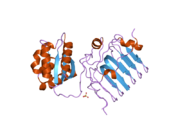Biology:RP2 (gene)
From HandWiki
Short description: Protein-coding gene in the species Homo sapiens
 Generic protein structure example |
Protein XRP2 is a protein that in humans is encoded by the RP2 gene.[1][2][3]
Function
The RP2 locus has been implicated as one cause of X-linked retinitis pigmentosa. The predicted gene product shows homology with human cofactor C, a protein involved in the ultimate step of beta-tubulin folding. Progressive retinal degeneration may therefore be due to the accumulation of incorrectly-folded photoreceptor or neuron-specific tubulin isoforms, followed by progressive cell death.[3] The RP2 protein is also involved in regulating the function and extension of the outer segment of cone photoreceptors in mice.[4][5]
References
- ↑ "Close genetic linkage between X-linked retinitis pigmentosa and a restriction fragment length polymorphism identified by recombinant DNA probe L1.28". Nature 309 (5965): 253–5. Jun 1984. doi:10.1038/309253a0. PMID 6325945. Bibcode: 1984Natur.309..253B.
- ↑ "Positional cloning of the gene for X-linked retinitis pigmentosa 2". Nat Genet 19 (4): 327–332. Sep 1998. doi:10.1038/1214. PMID 9697692.
- ↑ 3.0 3.1 "Entrez Gene: RP2 retinitis pigmentosa 2 (X-linked recessive)". https://www.ncbi.nlm.nih.gov/sites/entrez?Db=gene&Cmd=ShowDetailView&TermToSearch=6102.
- ↑ "Loss of Retinitis Pigmentosa 2 (RP2) protein predominantly affects cone photoreceptor sensory cilium elongation in mice". Cytoskeleton 72 (9): 447–54. Sep 2015. doi:10.1002/cm.21255. PMID 26383048.
- ↑ "Ablation of the X-linked retinitis pigmentosa 2 (Rp2) gene in mice results in opsin mislocalization and photoreceptor degeneration". Invest Ophthalmol Vis Sci 54 (7): 4503–11. 2013. doi:10.1167/iovs.13-12140. PMID 23745007.
Further reading
- "Genetic linkage between X-linked retinitis pigmentosa and DNA probe DXS7 (L1.28): further linkage data, heterogeneity testing, and risk estimation". Hum. Genet. 74 (2): 168–71. 1986. doi:10.1007/BF00282083. PMID 2876947.
- "Mapping the RP2 locus for X-linked retinitis pigmentosa on proximal Xp: a genetically defined 5-cM critical region and exclusion of candidate genes by physical mapping". Genome Res. 6 (11): 1093–102. 1997. doi:10.1101/gr.6.11.1093. PMID 8938433.
- "Protein-truncation mutations in the RP2 gene in a North American cohort of families with X-linked retinitis pigmentosa". Am. J. Hum. Genet. 64 (3): 897–900. 1999. doi:10.1086/302298. PMID 10053026.
- "Mutations in the RP2 gene cause disease in 10% of families with familial X-linked retinitis pigmentosa assessed in this study". Am. J. Hum. Genet. 64 (4): 1210–5. 2000. doi:10.1086/302325. PMID 10090907.
- "Genotype-phenotype correlation in X-linked retinitis pigmentosa 2 (RP2)". Ophthalmic Genet. 20 (3): 161–172. 1999. doi:10.1076/opge.20.3.161.2278. PMID 10520237.
- "A new Leu253Arg mutation in the RP2 gene in a Japanese family with X-linked retinitis pigmentosa". Invest. Ophthalmol. Vis. Sci. 41 (1): 290–3. 2000. PMID 10634633.
- "Novel frameshift mutations in the RP2 gene and polymorphic variants". Hum. Mutat. 15 (6): 580. 2000. doi:10.1002/1098-1004(200006)15:6<580::AID-HUMU15>3.0.CO;2-3. PMID 10862093.
- "X-linked retinitis pigmentosa: mutation spectrum of the RPGR and RP2 genes and correlation with visual function". Invest. Ophthalmol. Vis. Sci. 41 (9): 2712–21. 2000. PMID 10937588.
- "Mutations in the N-terminus of the X-linked retinitis pigmentosa protein RP2 interfere with the normal targeting of the protein to the plasma membrane". Hum. Mol. Genet. 9 (13): 1919–26. 2000. doi:10.1093/hmg/9.13.1919. PMID 10942419.
- "Identification of novel RP2 mutations in a subset of X-linked retinitis pigmentosa families and prediction of new domains". Hum. Mutat. 18 (2): 109–19. 2001. doi:10.1002/humu.1160. PMID 11462235.
- "[Identification of a nonsense mutation causing X-linked RP2 in two Chinese families]". Zhonghua Yi Xue Za Zhi 81 (2): 71–2. 2002. PMID 11798852.
- "Functional overlap between retinitis pigmentosa 2 protein and the tubulin-specific chaperone cofactor C". J. Biol. Chem. 277 (17): 14629–34. 2002. doi:10.1074/jbc.M200128200. PMID 11847227.
- "A comprehensive mutation analysis of RP2 and RPGR in a North American cohort of families with X-linked retinitis pigmentosa". Am. J. Hum. Genet. 70 (6): 1545–54. 2002. doi:10.1086/340848. PMID 11992260.
- "X-linked retinitis pigmentosa: RPGR mutations in most families with definite X linkage and clustering of mutations in a short sequence stretch of exon ORF15". Invest. Ophthalmol. Vis. Sci. 44 (4): 1458–63. 2003. doi:10.1167/iovs.02-0605. PMID 12657579.
- "RP2 and RPGR mutations and clinical correlations in patients with X-linked retinitis pigmentosa". Am. J. Hum. Genet. 73 (5): 1131–46. 2004. doi:10.1086/379379. PMID 14564670.
- "Clinical studies of X-linked retinitis pigmentosa in three Swedish families with newly identified mutations in the RP2 and RPGR-ORF15 genes". Ophthalmic Genet. 24 (4): 215–23. 2004. doi:10.1076/opge.24.4.215.17228. PMID 14566651.


